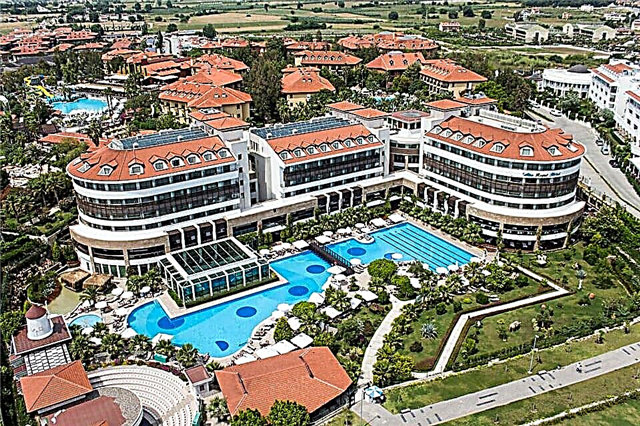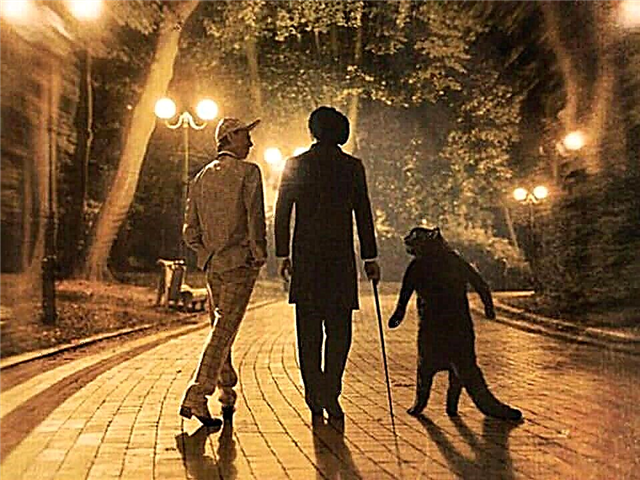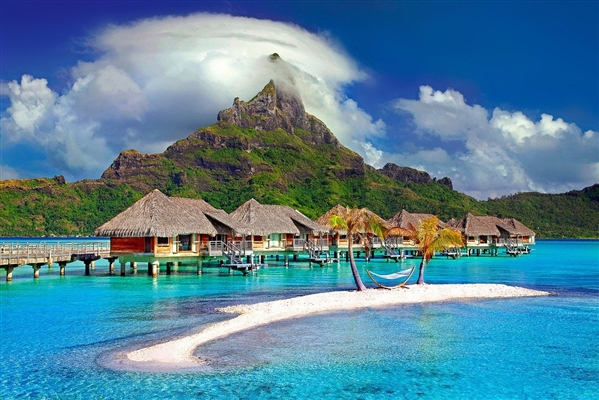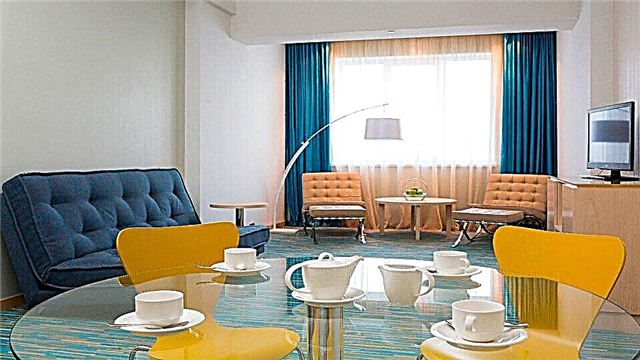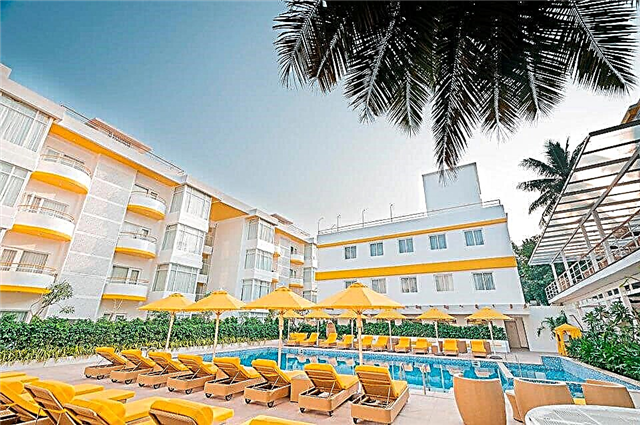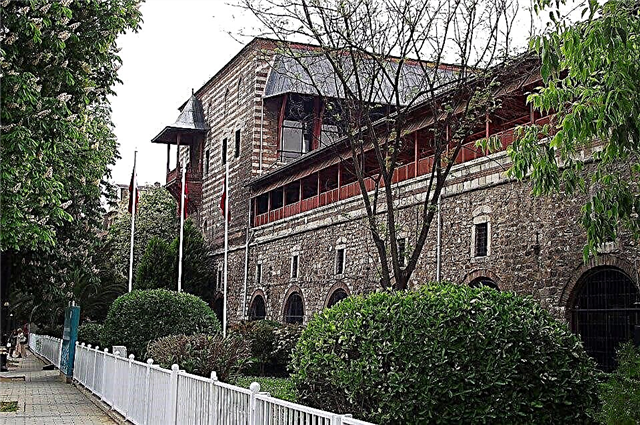Istanbul has a special magic arising from the harmonious fusion of several world religions and cultures. In the city founded in 667 BC. e., there are east and west, Byzantine, Greek, Genoese and Ottoman roots are closely intertwined. Here are collected unique historical objects and modern buildings.
The number of sights on the shores of the Bosphorus is in the hundreds. Therefore, alas, having come to this ancient city for a short time, it will not be possible to fully cognize it. However, there is a list of "must-have" places that every self-respecting tourist should visit. Ideas on what to see in Istanbul in 5 days on our own, we will share with you in our guide to the legendary Turkish metropolis.
First day
The lion's share of Istanbul routes begins in Sultanahmet, whose history goes back to 203. Today this name bears the central area of the metropolis (part of the Fatih district) and the ancient square - the concentration of unique objects that adorn the city since the time of Byzantium and the Ottoman Empire.
Hippodrome Square (Sultanahmet)

The center of public life in Byzantine Constantinople was the Hippodrome, founded in the 3rd century during the time of the Roman emperor Septimius Severus and rebuilt under the emperor Constantine. The main purpose of the square, the dimensions of which reached 450 m in length and 120 m in width, was to conduct chariot races.
Today, part of the Sultanahmet Square has settled on the site of the former Hippodrome. Here are witnesses of a bygone era that have survived to this day. The largest of these is the Egyptian obelisk brought from Cairo around 390. The stability of the granite monument, decorated with hieroglyphic symbols, weighing about 282 tons is striking: it was installed on only four metal supports and suffered several powerful earthquakes.
The second pillar of the Hippodrome - the obelisk of Constantine assembled from many stone blocks - was erected by Constantine VII, who decided to perpetuate the memory of his grandfather Basil the Macedonian I. Not far from the 21-meter colossus are the remains of the bronze Serpentine Column and the German Fountain presented to Abdul Hamid II by the German Emperor Wilhelm II ...
Blue Mosque

An acknowledged architectural masterpiece, the most impressive building in Istanbul and one of the most beautiful buildings in the world is the Blue Mosque, erected in 1616. It got its name thanks to the many (about 20,000) white and blue Iznik ceramic tiles used for interior decoration. The official name "Sultanahmet Mosque (Ahmedie)" was given to the temple in honor of the lord Ahmed I, who decided to appease Allah with the construction of a grandiose monastery.
For the construction of a pompous building, combining the styles of Ottoman and Byzantine architecture, only valuable rocks and the best marble were used. At the heart of the silvery-gray structure, crowned with 13 domes, lies a foundation 72 m long and 64 m wide. Next to the monumental building, six pointed minarets stretch to the sky - exactly as many as the Forbidden Mosque of Mecca had.
For non-Muslim tourists, the courtyard and a small part of the main prayer hall are open, over which a 43-meter dome rises. The walls are painted with suras from the Koran and patterns with plant motifs. The floor is covered with carpets decorated with floral ornaments. Light penetrating through 260 stained glass windows creates the illusion of lightness and volume.
Hagia Sophia Mosque
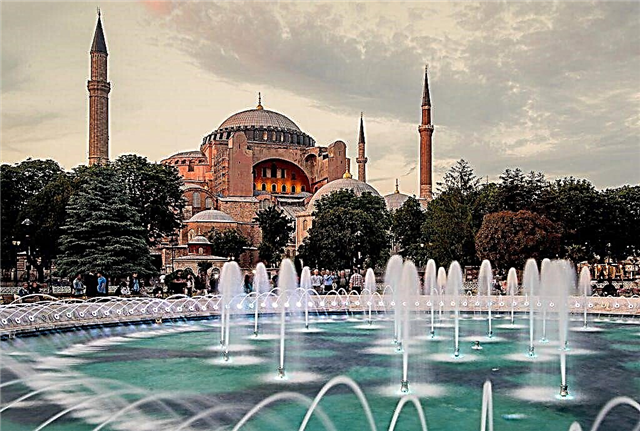
Opposite the Blue Mosque stands another famous landmark - Hagia Sophia. This magnificent building, the completion of which took place in 537, has been the site of Christian services for several centuries. The end of the history of the Orthodox cathedral coincided with the fall of Byzantium - in 1453 the temple was turned into a mosque. And in 1935 Mustafa Kemal Ataturk signed a decree to transform Hagia Sophia into a museum.
The mighty building is beautiful both outside and inside. The main decoration of the interior sparkling with precious stones is the Byzantine mosaics and frescoes. Oddly enough, the Ottomans rescued them from destruction, having putty the painting on the walls with ordinary plaster, which preserved the bright colors almost in their original form. The most valuable is the image of the Virgin surrounded by the emperors Constantine and Justinian.
Since 1935, there have been calls in Turkey to start Islamic worship in Hagia Sophia. In 2020, with the country's economy declining sharply due to the pandemic and relations with Orthodox Greece deteriorating, President Erdogan made a historic decision by signing a decree to use the museum as a mosque. Now tourists can visit the ancient walls for free, but the entrance during the prayers is prohibited.
Mosaic Museum
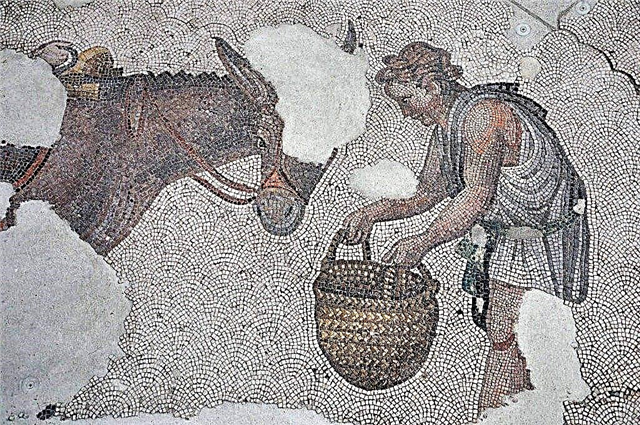
Inspection of the unique mosaic paintings, which began in Hagia Sophia, can be continued in the museum located on the territory of the former Great Palace of Constantinople. The amazing design on the stones was first discovered during construction work begun in the 30s of the XX century. Archaeologists who arrived at the excavation site found that the find was not an isolated one - the mosaic canvases covered an area of more than 4,000 square meters.
So, thanks to a happy coincidence, the Mosaic Museum appeared in Istanbul. In small galleries, located on two levels of a stone building, parts of the found floor panel are exhibited - from meter-long "canvases" to huge paintings. All exhibits are mesmerizing with their craftsmanship - each creation is made of terracotta, glass, marble and lime cubes, the size of which does not exceed 5 mm.
The collection of the museum includes 90 "paintings" of different genres. Visitors are presented with jewelry made of mythical plots and scenes of everyday Byzantine life: images of hunting, harvesting, feeding animals, children's games. In addition to mosaics, there are fragments of columns and porticoes that once adorned the peristyle of the Grand Palace.
Palace of Ibrahim Pasha

Everyone who watched the series "The Magnificent Century" was not left indifferent by the bright character of the film - Ibrahim Pasha. This extraordinary man, who has come a long way from the son of a fisherman to the grand vizier, is known as a skilled military leader and one of the most influential statesmen in the history of Turkey.
The house, located 900 meters from the Topkapi residence, was presented by Sultan Suleiman I to Ibrahim Pasha as a gift for the wedding of the vizier and Princess Hatice. The stone 4-storey building, built in the Old Ottoman style, bears little resemblance to a palace. The structure rather resembles an impregnable fortress surrounded by four courtyards.
Today, the Museum of Turkish and Islamic Art is located in the former palace of Ibrahim Pasha. Within its walls are collected about 40,000 exhibits introducing the works of Muslim art: from the Umayyad era (VII century) to the reign of the Ottoman dynasty.
The richest collection includes ancient manuscripts, household utensils, ceramic tiles, rare carpets, jewelry, samples of clothes of sultans and harem dwellers.
Basilica Cistern

The Basilica Cistern, almost 145 m long and 65 m wide, resembles a palace hall hidden in the underground. In fact, it is nothing more than a former reservoir for storing drinking water intended for the Grand Palace. It took two centuries to create the complex: construction began in the 4th century under the Emperor Constantine, and ended in 532 during the reign of Justinian.
Today, the Basilica Cistern is no longer used as a reservoir - it has turned into a unique museum.Descending 12 m on wet steps, its visitors find themselves in a huge hall. Twelve rows (each with 28 marble columns) support a gigantic 9,800 m² dome.
Impressive 4 m thick walls are covered with waterproofing insulation. The floor is a pool with a depth of about 0.6 m. Fish swim in the clear calm water, and the stone vault is reflected like in a mirror.
Special lamps and spotlights cast subdued light over the impressive architecture of the underworld. The mysterious atmosphere of the Basilica Cistern is mesmerizing. A mystical touch to this place is given by its main attractions - the inverted heads of Medusa the Gorgon, which adorn the bases of the two central columns.
Cistern Feodosia

Another former reservoir of Constantinople, Theodosius Cistern, is a 5-minute walk from the Hippodrome Square. It was built during the reign of the Roman emperor Theodosius II between 428 and 443. The underground room was used to store water coming from the Valens aqueduct, intended to supply the Nymphaeum, the baths of Zeusippus and the Great Palace of Constantinople.
An abandoned tank located under an old mansion was discovered only in 2010. Restoration work began in 2014, and 8 years later the Feodosia Cistern was opened to visitors. For the convenience of tourists, the floor, covered with a thin layer of water, was equipped with wooden platforms.
Unlike the columns of the Basilica Cistern, taken by the Byzantines from various temples, the columns of Theodosia Cistern were made especially for this place. In total, 32 stone pillars with a height of 9 m, fortified with iron hoops, rise in the room.Together they support brick ceiling arches measuring 42x25 m.
Bayezid Mosque

The Bayezid Mosque, located on the square of the same name in the western part of Sultanahmet, was founded in 1500 by the order of Bayezid II. The eighth sultan entrusted the construction of the temple to the architect Yakubshah Bin Sultanshah, who combined the early Ottoman, Byzantine and classical styles in his brainchild.
The building of the mosque, for the construction of which was used granite, marble and porphyry, is preceded by a small shady courtyard. Old cypress trees grow inside it, and a marble fountain gives coolness. The appearance of the temple resembles Hagia Sophia: the central 17-meter dome is also supported by smaller semi-domes. Two minarets are at a distance of 100 m from each other.
Today, the Bayazid Mosque is part of a vast religious complex. It includes an imaret and a caravanserai, which are run by the city library, a hammam and a museum of calligraphic art. Behind the temple is the Sahaflar book market, and on the south side there are mausoleums, in one of which Bayezid II rests.
Suleymaniye Mosque

On one of the city hills rises the second largest mosque in Istanbul - the magnificent Suleymaniye. With the construction of this temple, Sultan Suleiman I marked his victory over the Kingdom of Hungary, proving to the whole world that the Ottoman Empire is a powerful state. The unsurpassed architectural creation, which took seven years to create, was the author of the best Turkish architect Mimar Sinan.
Suleymaniye's appearance is simple and elegant. At the corners of the mosque there are four minarets with ten balconies. This is deeply symbolic: Suleiman the Magnificent was the fourth padishah of Istanbul and the tenth sultan of the Ottoman Empire. The huge prayer hall covers an area of 3,500 m². Four powerful pillars support the main dome, which is 27.75 m in diameter and 48.5 m high.
In the garden behind the main mosque, noble people of the Ottoman dynasty sleep in eternal sleep. Suleiman I and his only wife, Haseki Khyurrem Sultan, are buried in richly decorated tombs. Princesses Hatice and Mihrimah, as well as sultans Ahmed II and Suleiman II, are also buried here. Next to the walls of the temple is the mausoleum of the architect Mimar Sinan.
On a note. Round off a busy day at Seven Hills, a restaurant serving delicious seafood dishes and the freshest fish caught in the Sea of Marmara. The average bill is 180 liras. Book in advance a table in the corner of the hall or on the terrace, and then during dinner you can enjoy the beautiful views of the Bosphorus and the ancient mosques.
Second day
In the 7th century BC. NS. on the southern coast of the bay, from a bird's eye view resembling a curved horn, the ancient Greek city of Byzantium was founded, which was named Constantinople a few centuries later. Today, in the vicinity of the coast of the legendary harbor, famous sights are spread, to which we propose to devote the second day of the trip. And the excursion program can be completed with a boat trip along the Bosphorus.
Hill and coffee house Pierre Loti

In the upper reaches of the Golden Horn, in the Eyup region, the Pierre Loti hill rises. It owes its name to the French sailor and writer Louis Marie-Julien Vio. The author, who wrote under the pseudonym Pierre Loti, devoted his debut novel to the love of a Turkish woman and an officer from France.
The work is based on the personal story of Vio, who met the beautiful Asiada in Istanbul. In his memoirs, the novelist often mentioned his favorite places - a picturesque hill and a cozy cafe in the shade of old cypress trees.
Tourists climb to the top of the hill for one of the best observation platforms in the city, located at an altitude of 53 m above sea level. You can get here by funicular TF2 or on foot, following the Eyup Mosque and the Muslim cemetery. The way up will take no more than 30 minutes.
In addition to the unique views opening from the hill, Pierre Loti is known for the eponymous coffee shop located next to the observation deck. This establishment with an open terrace is very popular among tourists, so it's better to come here in the morning.
The choice of dishes is not great: from food - only gözleme - flat cakes with various fillings. On the other hand, delicious Turkish coffee and aromatic apple tea are served here.
Walls of Constantinople (Feodosia)

In the 5th century, the ruler of Constantinople, Emperor Theodosius II, decided to erect fortress walls designed to protect the city from hostile raids by barbarians. Prefect Anfimy was entrusted to implement the project. The creation of the fortification lasted from 408 to 413, its length was 5 630 m.
After the destruction of part of the bastion caused by the 740 earthquake, the walls had to be rebuilt. At the same time, a wide moat and 110 towers appeared, 17 of which were equipped with passage gates. The main entrance to the city was through the front Golden Gate - a three-span marble arch decorated with bas-reliefs and crowned with a statue of the goddess of Victory.
At the end of the 19th century, as the territory of Istanbul expanded, the ancient walls began to be demolished. The restoration of the dismantled land fortification, hundreds of years ago, covering the western borders of Constantinople, began in the 80s of the last century with funds allocated by UNESCO. Today, the best-preserved part of the former fortress wall can be seen in the Fatih area.
Mosque Mihrimah Sultan

The grandiose building, which has attracted the eye with the harmony of graceful lines for five centuries, is named after the only daughter of Suleiman the Magnificent. Having married Rustem Pasha, Mihrimah, who has an extraordinary mind, gained access to state affairs. This increased the already fabulous state of the princess, who devoted a lot of attention to charity. With her money, two mosques were built, one of which rises 300 meters from the Constantinople walls.
For the role of the architect, Mihrimah Sultan chose Mimar Sinan. Secretly in love with the archbishop's daughter, the architect embodied his feelings in a sophisticated building, the construction of which took only four years. Built in 1565, the mosque has only one minaret - a symbol of the loneliness of Mihrimah, who lost her mother in 1558 and her husband three years later.
The interior decoration of the mosque is mesmerizing. The stone walls are decorated with mosaic paintings and exquisite elements of marble, ivory, gold and mother-of-pearl. Thanks to the many arched windows, daylight enters the building, making the room look like a sparkling crystal ball. The impression of lightness is also created by the absence of heavy interior details.
Kariye Museum

A repository of priceless mosaics and frescoes created by Byzantine craftsmen in the 14th century is a museum opened in the former Church of Christ the Savior in Chora (in Turkish pronunciation - Kariye). The Orthodox church received this name from the Chora Monastery, presumably founded in the XIV century. In 1945, after the formation of the Turkish Republic, the restored church was transformed into a museum.
Outwardly, the facade of the monastery looks austere, but once you look inside, the picture changes dramatically. The museum consists of three rooms: the lobby, the main hall and the tomb. The ancient walls are lavishly decorated with mosaic paintings and frescoes, the main theme of which is biblical subjects. The milestones of the life of Jesus Christ, the Mother of God and the saints are presented before the eyes of visitors.
In 2020, the former Chora monastery suffered the fate of the Hagia Sophia - it acquired the status of a mosque. You can visit it for free at any time, except for namaz and prayer hours. However, the entrance to the museum is still paid.
Balat and Fener

To truly get to know the city, it is not enough to follow only the trails laid by millions of visitors to the Turkish metropolis. Therefore, we invite you to immerse yourself in the spirit of non-tourist Istanbul and go to the place where the buildings have not changed at all since the Middle Ages, where clothes are dried on the ropes stretched between the houses, and the aroma of almond coffee soars in the air. To Balat and Fener.
Until the 1950s, Balat was known as the Jewish quarter. Fener has been inhabited for centuries by Greeks who moved here after the fall of Constantinople. It is impossible to draw a clear line between these two atmospheric regions. Jewish families live side by side with Muslim, Armenian and Greek families, and Orthodox churches are interspersed with mosques and synagogues.
Balat and Fener owe much of their popularity to the narrow streets bordered by colorful houses, which have become a favorite place for fans of Instagram shots. After the photo shoot, visit the Orthodox Cathedral of St. George, the Iron Church of St. Stephen, the medieval ruins of the Lesser Blachernae Palace and visit the vintage shops of local artists.
Tour of the Bosphorus by boat

A great option to rest your feet after a long walk is to ride on the Bosphorus by boat (vapur) or sea bus (deniz otobüs). The main pier of the embankment of the Golden Horn is Halich (Eminönü Haliç), located near the Galata Bridge. Ride prices vary depending on the route. In addition, you can pre-order a boat tour with a Russian-speaking guide.
During the cruise, along the way, you can encounter both stately liners and small fishing boats, whose inhabitants often sell fried mackerel sandwiches to tourists. In some places, the Bosphorus is so narrow that you can't believe how ships manage to avoid collisions.
From the water, the sights of Istanbul appear in a completely different light. During the water trip, you will see the most beautiful architectural masterpieces of both the European and Asian parts of the city: the Bosphorus Bridge, the Rumelihisar fortress, the Ortakoy mosque, the Dolmabahce, Chiragan and Beylerbeyi palaces, the Maiden Tower. By the way, from the boat you can watch flocks of fish and jellyfish of various shapes and colors swimming below.
Third day
Beyoglu, one of the most ancient and picturesque districts of the metropolis, settled to the north of the Golden Horn Bay. The first settlements appeared here about 8,000 years ago. Tourists know this place from its historical core - the Galata district, as well as from Istiklal Street and Taksim Square.
Galata bridge

Everyone who comes to the city takes with them photographs from the place where East and West meet. This is the Galata Bridge, the wooden predecessor of which was built in 1845 by order of the mother of Sultan Abdul-Majid I. Since then, the crossing of the Bosphorus has been repeatedly reconstructed. The last transformation dates back to 2005 - it was then that the huge structure acquired tram lines.
The modern Galata Bridge is a two-storey structure, 484 m long and 42 m wide, erected on concrete piles. The central 80-meter part is movable. The first tier is a pedestrian zone, the second is a three-lane carriageway.
The sidewalks of the upper floor of the Galata Bridge were chosen by local fishermen who come here to fish and communicate. Street food vendors scurry about here: the famous balyk ekmek fish sandwiches, fried chestnuts, kokorech and stuffed mussels. The lower tier is filled with restaurants ranging from cheap eateries to high end establishments.
On a note. If you are a fan of Instagram and bright positive photos, take a short detour after the Galata Bridge to the right into Necatibey Cd. After 450 m you will find Hoca Tahsin Sok. - the very same street in the Karakoy area, above which dozens of multi-colored umbrellas soar. In addition, colorful graffiti on the walls of houses and picturesque verandas of cozy cafes will become a wonderful background for pictures.
Galata tower

600 meters from the legendary bridge is another landmark of Galata - the famous Galata Tower. Its history began almost 1,500 years ago, when in 527 the emperor Justinian the Great built a wooden lighthouse near the shores of the Bosphorus. The structure, which was rebuilt many times, received an appearance close to the modern one in 1875.
The height of the 9-storey structure is 67 m. Since the building stands on a hill, it seems even higher, dominating the city landscape. The thickness of the stone walls is 3.75 meters. According to the calculations of the design engineers, the tower weighs about 10,000 tons, which is equivalent to the weight of 36 wide-body aircraft.
At the foot of the tower there is an elevator and a staircase leading to the top of the building, where there is an observation deck. From a height of 51.65 m, stunning views open up: the Golden Horn in the south, Beyoglu in the north and the Bosphorus and the Asian part of Istanbul in the east. You can also admire the panorama of the metropolis from the windows of the restaurant and cafe located here.
Istiklal

Walking 100 m north of the Galata Tower, you will find yourself on the most famous Istanbul street - the colorful Istiklal, whose name translates as "independence". The history of the promenade, which stretches for 1.4 km to Taksim Square, began during the reign of Suleiman I. At that time, next to this small street there was a gate through which the road to Istanbul passed.
The cosmopolitan pedestrianized street is famous for its many shops, gift shops, restaurants, nightlife and famous landmarks. Walking along Istiklal, you will see the Temple of Antoine of Padua, the Neve Shalom Synagogue, the Church of the Holy Trinity, the Hussein Agha Mosque, the Church of St. Mary Draperis and the Galatasaray Lyceum founded in 1481.
One of the most striking buildings in Istiklal is Chichek Passage (Flower Passage). The neoclassical building, which attracts attention with a glass dome, gilded stucco and graceful arches, was built in 1876. It got its name thanks to emigrants from Russia, who opened flower shops here in the 1920s. Today this place is popular among connoisseurs of elegant interiors, oriental music and Turkish national cuisine.
Madame Tussauds museum

In the shopping center "Grand Pera" on Istiklal there is one of the modern city attractions - Madame Tussauds Museum. Finding him is not difficult - the wax counterpart of Bruce Willis flaunts in the window.At the time of opening (2016), there were 55 figures in the Istanbul branch of the famous London museum. And this is not the limit: every year the collection is replenished by 3-4 characters.
Visitors are greeted by a model of the legendary red retro tram. The exposition opens with the "eastern" hall, at the head of which the father of the Turkish Republic, Mustafa Kemal Ataturk, froze. The country's outstanding personalities are located nearby: the sultans Mehmed II the Conqueror and Suleiman the Magnificent, the architect Mimar Sinan, the Sufi mystic Jalaladdin Rumi, the first female pilot Sabiha Gokcen.
In addition to national heroes, the museum has amazingly realistic copies of famous world scientists, inventors, athletes, actors, musicians, show business stars and heroes of popular cartoons. One of the halls is dedicated to the technology of making wax exhibits. Here you can also get a cast of your own hand.
Taksim Square

One of the most famous squares in Istanbul is Taksim, so named due to the water distribution structure built here in the 18th century (Turkish taksim). This is, perhaps, the most "densely populated" place of the megalopolis with townspeople and tourists. Istiklal Street starts from here, central avenues and boulevards converge here.
The main attraction of Taksim is the Republic Monument, which has been towering 12 m above the square since 1928. It is noteworthy that in his creation the sculptor depicted not only important political figures of Turkey led by Ataturk, but also Soviet revolutionaries: Aralov and Voroshilov.
While walking around the square, do not forget to take pictures with the historic tram "nostalzhik", as the locals call it. A prototype of this vehicle appeared on the streets of the city in 1871. Today, a red trailer with openings instead of doors and an original wooden interior runs along the Taksim - Tunel station route, carrying 5,000-6,000 people daily.
Church of the Holy Trinity

To the south of Taksim Square is one of the largest Orthodox churches in the city - the Church of the Holy Trinity, created according to the drawings of the architect P. Kampanaki. Earlier on the site of the monastery there was a Greek cemetery and a small wooden church. The new parish opened its doors to believers in September 1880.
Outwardly, the Church of the Holy Trinity differs from Istanbul's Orthodox churches. The building, in the center of which rises a frescoed dome topped with a cross, was built in the neo-baroque style, complemented by elements of the basilica. The facade, decorated with carvings and stained-glass windows, is framed by two four-tiered Gothic bell towers.
Thanks to 12 domed windows, symbolizing the apostles of Christ, the atmosphere inside the temple is enveloped in light and tranquility. Ceiling frescoes serve as the main decoration of the interior. The walls are hung with Greek icons, many of which were created during the Byzantine Empire. In the church you can worship the imperishable relics of St. Theophany, Solomonia and Euphemia the All-Praiseworthy.
Fourth day
Without a visit to the Asian part, acquaintance with Istanbul can be considered invalid. Therefore, we suggest that you take a ferry and go to the right bank of the Bosphorus - to the Kadikoy region. And on the way back, walk along the embankment of the European side of the legendary strait and visit two beautiful pearls of the ancient city: Dolmabahce Palace and Ortakoy Mosque.
Baghdad avenue

The most visited tourist destination on the Asian side of the city is Baghdad Avenue - part of the ancient Roman road that connected Byzantium with the Lycian cities. The 14-kilometer avenue, which runs parallel to the coast of the Sea of Marmara in the Kadikoy region, got its name in honor of the victory of Murad IV in the Turkish-Persian war of 1635-1639.
In terms of the number of stores, Baghdad is ready to compete even with Istiklal - the recognized trade Mecca of the metropolis. Not far from the Kadikoy pier, on the section of the avenue between Kyzyltoprak and Suadiye streets, dozens of department stores and boutiques are concentrated: from the Marks & Spencer multi-storey center to the Istanbul branch of Louis Vuitton.
It is never boring here. Very often, the street becomes the epicenter of presentations and popular events such as the spring shopping festival, the Republic Day parade and the Fenerbahce football fan march. In the evenings, the restaurants and nightclubs of Baghdad are besieged by the local "golden get-together", in the ranks of which you can meet famous Turkish designers, artists and actors.
Haydarpasha station

In May 1906, the construction of the Haydarpasa station began, on the creation of which the German architects Otto Ritter and Helmut Kuno worked. In August 1908, on the right bank of the Bosphorus, the opening of the station took place, which became an important point of the railway connecting Berlin and Baghdad. With her help, the German Empire wanted to implement plans to expand its influence in the East. The project was funded by Deutsche Bank.
Haydarpasha is a monumental neoclassical building with an area of almost 4,000 m². The sandstone façade is adorned with Baroque clocks and round turrets. The structure is placed on a platform resting on 22-meter oak piles (a total of 1,100 pieces). This design made it easier to dock with ferries arriving from the European side.
In November 2010, during the restoration work, a fire broke out, as a result of which the roof and the fourth floor were partially destroyed. In connection with this event, as well as with the construction of the Marmaray railway underwater tunnel, Haydarpasha was closed in 2013. The city authorities plan to open a museum in one wing of the former railway station, and a hotel and a shopping center in the other.
Maiden's Tower

The Maiden Tower (or Kyz Kulesi, as the locals call it) was presumably created at the dawn of the 1st millennium. There is no exact data on the year of the beginning or completion of the construction of this architectural monument. According to one version, the building was erected during the era of wars between Sparta and Athens (411 AD). According to another interpretation, the tower appeared during the reign of Constantine and played the role of a sentry fort.
There are many legends explaining the name of the romantic building. One of the legends tells about the daughter of the Sultan. Once the oracle predicted the princess's death from a snakebite on the day of her majority. To prevent misfortune, the ruler imprisoned his daughter in a tower in the middle of the Bosphorus.
When the girl turned 18, her father brought her a basket full of exotic fruits. However, the beloved child of the Vladyka did not have a chance to enjoy the juicy fruits: a poisonous snake hiding in a basket bit the princess. The prophecy has come true.
The modern life of the Maiden Tower began in 1992, when, with the assistance of the mayor of the city, the building acquired the status of a cultural center. After a global renovation, an observation deck, a restaurant, a bar and a souvenir shop appeared here. You can get to the attraction by boat, which runs every 15 minutes from the berths of Salacak or Kabataş.
Dolmabahce

In the middle of the 19th century, Abdul-Majid I, who dreamed of “opening a window to Europe”, decided to change the medieval Topkapi for a more luxurious “western” dwelling. So in 1856, a new residence of the Sultan appeared on the shores of the Bosphorus - the delightful Dolmabahce Palace.
On an area of 45,000 m² there are 46 halls, 285 rooms, 68 toilets and 6 hammams. All this splendor is hidden behind a 600-meter facade, made in the styles of Rococo, Baroque and Neoclassicism.
The spectacular interiors are decorated no worse than the best royal castles in Europe. The pompous rooms are decorated with gilded ceilings, columns and arched arcades, handmade carpets and exquisite wall paintings. Among the treasures of the palace are a collection of paintings by Aivazovsky and the largest chandelier in the world, donated to Abdul-Majid I by Queen Victoria of England.
Today's Dolmabahce is a national museum.Its main value is the original historical interiors: the Sufer Hall, the ceremonial hall, the Sultan's chambers, the imperial staircase and the harem rooms. The most important exhibit of the collection is the bed, which in November 1938 became the death bed of Mustafa Kemal Ataturk.
Ortakoy Mosque

One of the most spectacular mosques in the city is Ortakoy or Medshidiye Great Mosque. A true masterpiece of oriental architecture appeared on the European coast of the Bosphorus in 1854, replacing the temple that was previously located here, which was destroyed during the popular uprising of 1730. However, a difficult fate awaited the new monastery: an earthquake, and then a fire, caused serious damage to it.
The last restoration work ended at the beginning of the 21st century. The modern Ortaköy Mosque is an elegant structure whose architecture combines the styles of neoclassicism and Ottoman Baroque. Two white marble minarets rise above the dome. The top of each is crowned with a sheref balcony. The chambers of the Sultan and the harem are adjacent to the building of the temple.
The interior decoration of the mosque is even more beautiful than its facade. The walls of the monastery are lined with panels of pink mosaic and decorated with Arabic calligraphy. Thanks to the huge windows, the prayer hall is filled with rays of daylight. And in the evening, a huge crystal chandelier illuminates the room.
Fifth day
The cherry on the cake of an Istanbul trip will be a visit to a striking example of medieval Ottoman architecture - the Topkapi Sultan's Palace. In addition, for the "dessert" of the five-day trip, we left the natural beauty of Gulhane Park, the ancient exhibits of the Archaeological Museum and the colorful shopping arcade of the Grand Bazaar.
Topkapi

In 1459, at the top of Cape Sarayburnu, on the place where the Church of St. Irene stood alone, the construction of the Sultan's palace began. The initiator of the construction was Fatih Mehmet (the Conqueror). The palace, which until 1839 served as the official residence of 25 Ottoman rulers, was named "Topkapi", which means "cannon gate".
In the following centuries, numerous changes were made to the architecture of the palace complex. The largest of them - the creation of a harem - dates back to the 16th century. In 1923 Topkapi was transformed into a museum. The numerous halls display the priceless treasures of the Ottomans.
In addition to golden thrones and bejeweled clothing, Topkapi's emerald and diamond encrusted dagger and the 86-carat Spooner diamond can be seen here. Of particular value is the sacred "Banner of the Prophet", as well as hair from the beard and a shard of Muhammad's tooth.
Even a quick tour of all the premises of the 700,000 m² palace complex will take at least 2 hours. Just think: Topkapi consists of four gigantic courtyards, each of which contains several large buildings. The most visited part by tourists is the harem, which consists of 300 rooms, a hospital, baths and two mosques.
Gulhane Park

Near the Sultan's palace, there is an island of nature and silence - Gulhane Park. During the Ottoman dynasty, this green oasis, whose name is translated from Turkish as "house of roses", was part of the imperial gardens of Topkapi. Entrance here to mere mortals was ordered: only members of the ruling family could rest in the shade of dense trees.
In 1912, the sultans' holdings were redesigned and opened to the general public. Today, connoisseurs of picturesque landscapes and leisurely walks come to the park. On the territory of Gulhane, you can visit the Pavilion of Parades, the Museum of Islamic Science and Technology and see the famous Gothic Column dating from the III-IV century.
With the onset of spring, Gulhane turns into a kingdom of tulips. A colorful extravaganza dedicated to the national symbol of Turkey starts at the end of March. At this time, the whole city smells fragrant, but one of the main sites of the festival is the Topkapi Park. At this time, thousands of flowers are planted here, making up beautiful living panels. Positive emotions and vivid photos are guaranteed!
Archaeological Museum

Founded in 1891 by Osman Hamdi Bey, who led the excavations in Lebanese Sidon, where one of the flagships of the Istanbul collection was discovered - the sarcophagus of Alexander the Great. Today, the exposition, which includes more than 1 million rarities, is housed in a complex of three buildings next to Gulhane Park.
The collection of the museum consists of priceless relics from Ancient Greece, Egypt, Anatolia, Mesopotamia, Ancient Rome, Assyria, Sumer, Akkad and Babylon. Among the exhibits are tombs, statues, bas-reliefs, busts, obelisks, coins, weapons, chariots, parts of columns and many other artifacts.
The most impressive objects are fragments of the Babylonian Ishtar Gate, decorated with colorful images of mythical creatures. Of great interest are also Lycian sarcophagi, Egyptian mummies, samples of Hittite cuneiform from 1700 AD, Ottoman and Seljuk ceramic tiles.
Grand Bazaar

"A huge hive of thousands of little shops." This definition was given in 1867 to the Grand Bazaar by Mark Twain. The words of the American writer are still relevant today. This gigantic 30,700 m² indoor market is more like a vibrant urban area. There are not only 4,400 shops and 12 warehouses here. On the territory of the bazaar, 61 streets were laid, 12 mosques, a hammam, a school and several cafes were opened.
The history of the Grand Bazaar began in 1453, when Mehmed II decided to erect two wooden bedstans (covered pavilions) in the city, around which shopping arcades grew year after year. Over the years, the market, repeatedly destroyed by fire, each time, like the Phoenix, was reborn from the ashes. The Grand Bazaar acquired its modern look at the end of the 19th century.
Shopping arcades dazzle with variety and brightness. In labyrinths fragrant with spices and aromas of oriental spirits, you can find jewelry, clothes, accessories, ceramics, souvenirs, carpets, textiles, spices, dried fruits, sweets and much more. For the convenience of visitors, each product group is presented on a specific street.
How to get to the center on your own
Today, Istanbul has two operating airports: Sabiha Gokcen Airport (SAW), which receives domestic flights and European low-cost airlines, and the New Airport (IST), where most of the tourists arrive. The air gate, which opened in 2019, is 41 km from the historic Sultanahmet district.
There are three ways to get from the terminal to the city center:
- By buses of the HavaIst company. To board, follow signs for Otobüs / Servis / Araç. The most popular routes are HVIST-12 (terminal station - Bayazid mosque, Sultanahmet) and HVIST-14 (terminal station - Taksim square). Depending on traffic density, travel time ranges from 50 minutes to 1 hour 15 minutes.
Please note: travel can only be paid with a bank card or IstanbulCart (sold in yellow machines or kiosks at bus stops). - Transfer from the host hotel (private car or minibus shuttle). The journey will take about 45 minutes, the price of the trip is fixed and is about 150 liras.
- Round-the-clock taxi. The car can be ordered in advance through the official applications of carriers (Bitaksi, Uber, KiwiTaxi) or taken on the spot (choose yellow cars - they are more affordable). The journey will take about 45 minutes, the price of the trip is about 200 liras.
Soon, the city authorities are planning to open a metro station of the M11 line at the New Airport.

